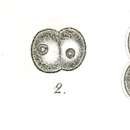fr
noms dans le fil d’Ariane


Chlamydomonadales, also known as Volvocales, are an order of flagellated or pseudociliated green algae, specifically of the Chlorophyceae.[1] Chlamydomonadales can form planar or spherical colonies. These vary from Gonium (four to 32 cells) up to Volvox (500 cells or more). Each cell has two flagella, and is similar in appearance to Chlamydomonas, with the flagella throughout the colony moving in coordination.
Both asexual and sexual reproduction occur. In the former, cells divide until they form new colonies, which are then released. In the smaller forms, typically all cells are involved, but larger forms have anterior vegetative and posterior reproductive cells. Sexual reproduction varies from isogamy (both genders produce flagellated gametes of equal size) to oogamy (one gender produces a much larger, nonmotile gamete).
The classification of the Chlamydomonadales varies. Very often they are taken to include the orders Volvocales and Dunallielales, which contain closely related unicellular flagellates, as suborders. Colony inversion is believed to have arisen twice in this order. Spheroidal colony formation differs between the two lineages: rotation of daughter protoplasts during successive cell divisions in Astrephomene, and inversion after cell divisions in the Volvocaceae.[2]

As of May 2023, AlgaeBase accepted the following families:[3]
Chlamydomonadales, also known as Volvocales, are an order of flagellated or pseudociliated green algae, specifically of the Chlorophyceae. Chlamydomonadales can form planar or spherical colonies. These vary from Gonium (four to 32 cells) up to Volvox (500 cells or more). Each cell has two flagella, and is similar in appearance to Chlamydomonas, with the flagella throughout the colony moving in coordination.
Both asexual and sexual reproduction occur. In the former, cells divide until they form new colonies, which are then released. In the smaller forms, typically all cells are involved, but larger forms have anterior vegetative and posterior reproductive cells. Sexual reproduction varies from isogamy (both genders produce flagellated gametes of equal size) to oogamy (one gender produces a much larger, nonmotile gamete).
The classification of the Chlamydomonadales varies. Very often they are taken to include the orders Volvocales and Dunallielales, which contain closely related unicellular flagellates, as suborders. Colony inversion is believed to have arisen twice in this order. Spheroidal colony formation differs between the two lineages: rotation of daughter protoplasts during successive cell divisions in Astrephomene, and inversion after cell divisions in the Volvocaceae.
 Schematic representation of the phylogenetic relationships of the volvocine algae and the parallel evolution of the spheroidal colony. Volvocine algae range from the unicellular Chlamydomonas to the multicellular Volvox through various intermediate forms and are used as a model for research into the evolution of multicellularity. The spheroidal colony is thought to have evolved twice independently within this group: once in the Volvocaceae, from Pandorina to Volvox, and the other in the genus Astrephomene. The phylogeny is based on previous reports. All drawings and photographs represent side views of individuals with anterior ends orienting toward the top of this figure.
Schematic representation of the phylogenetic relationships of the volvocine algae and the parallel evolution of the spheroidal colony. Volvocine algae range from the unicellular Chlamydomonas to the multicellular Volvox through various intermediate forms and are used as a model for research into the evolution of multicellularity. The spheroidal colony is thought to have evolved twice independently within this group: once in the Volvocaceae, from Pandorina to Volvox, and the other in the genus Astrephomene. The phylogeny is based on previous reports. All drawings and photographs represent side views of individuals with anterior ends orienting toward the top of this figure.
Em taxonomia, Chlorosarcinales é uma ordem de algas verdes, especificamente das Chlorophyceae.[1]
Em taxonomia, Chlorosarcinales é uma ordem de algas verdes, especificamente das Chlorophyceae.